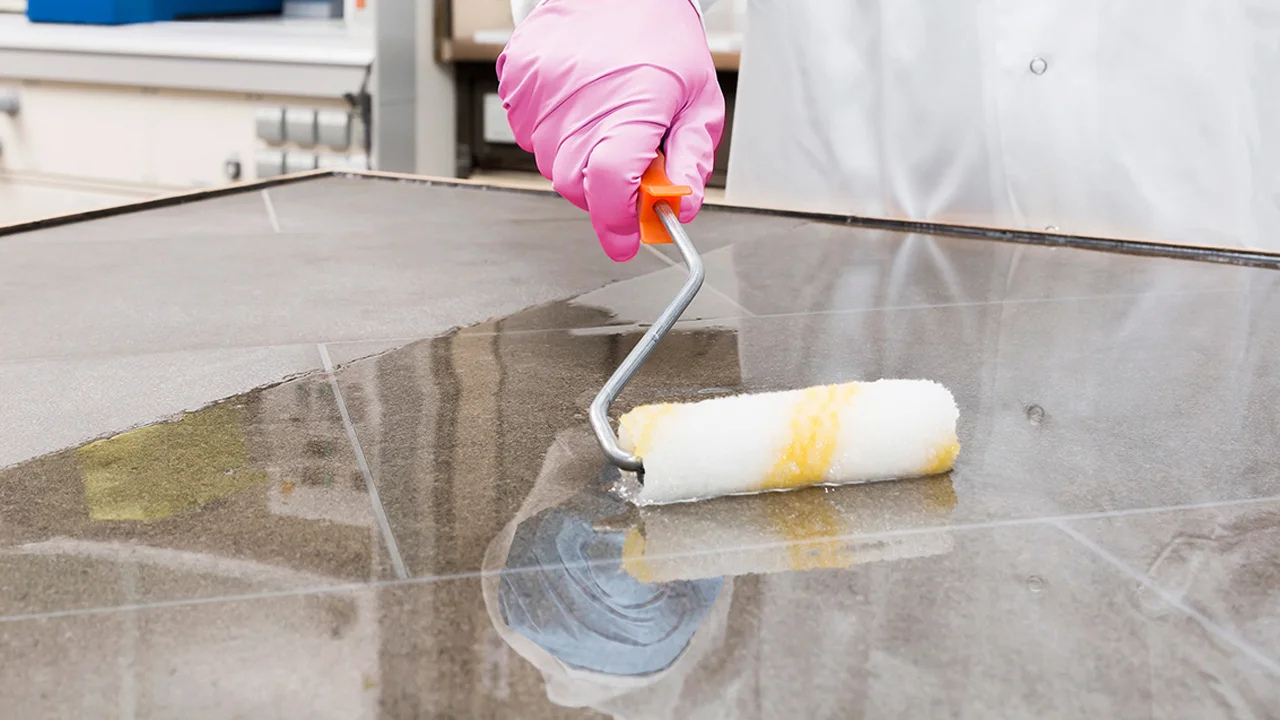
Tiled surfaces are commonly used in moisture-prone areas such as bathrooms, showers, kitchens, balconies, and terraces due to their aesthetic appearance and durability. However, despite their water-resistant surface, water seepage may occur through grout joints or due to inadequate waterproofing underneath the tiles. This can lead to water damage in lower floors, mold growth, and even structural issues within the building. So, which waterproofing materials can be applied directly over tiled surfaces? In this article, we will explore the answer to this question with technical detail.
Why Waterproofing Over Tiled Surfaces Is Necessary
While the surface of tiles is generally water-resistant, the grout joints between them can crack or become porous over time. Water may also accumulate in voids behind the tiles, leading to long-term damage to the underlying structure. In outdoor applications like terraces and balconies, rainwater can seep beneath the tiles and penetrate the concrete slab, compromising the integrity of the building. Therefore, applying an additional waterproofing layer over existing tiles is often essential.
Key Criteria for Selecting Waterproofing Materials for Tiled Surfaces
When choosing a waterproofing product for use over tiles, it must meet the following technical requirements:
- High adhesion strength to smooth surfaces
- Elastic and crack-bridging properties
- UV resistance for outdoor use
- Walkable or coatable surface after curing
- Breathability (water vapor permeability)
- Strong chemical and environmental durability
Types of Waterproofing Materials Applicable Over Tiles
1. Transparent Polyurethane-Based Waterproofing Coatings
These are clear, high-performance products designed to form a waterproof membrane without altering the appearance of the tiles. Available as one- or two-component systems, they form a transparent, glossy film layer upon curing.
Advantages:
- Maintains the existing aesthetic of the tiles
- No need for additional top coatings
- Easy brush or roller application
- Highly elastic once cured
Considerations:
- Surface must be clean and dry
- Grout lines should be intact and properly sealed
2. Liquid Membrane Systems
Liquid-applied membranes based on polyurethane, acrylic, bitumen-polymer, or hybrid resins create a seamless waterproof layer over the tiled surface. These are applied using brush, roller, or airless spray equipment.
Advantages:
- Excellent for detailing and difficult geometries
- Layer-by-layer application allows for thickness control
- Some are UV-resistant and suitable for outdoor use
Considerations:
- Not all formulations support tile re-installation over them
- Primer may be required for proper adhesion
3. Transparent Water Repellents (Liquid Glass Coatings)
Also known as liquid glass or siloxane-based coatings, these breathable and water-repellent treatments can be applied directly over tile surfaces.
Example: Dryfix Liquid Glass – Glassy 100
This environmentally friendly product adheres to a wide range of substrates including tiles, marble, granite, stone, and concrete.
Advantages:
- Odorless and VOC-free
- Preserves the natural appearance of the surface
- Ideal for indoor applications
Considerations:
- May have limited long-term UV stability in outdoor settings
- Not suitable for high water pressure zones
4. Epoxy-Based Waterproofing Systems
Epoxy resins are commonly used in interior settings where high hygiene and chemical resistance are required—such as industrial kitchens, laboratories, and food processing areas.
Advantages:
- Exceptional chemical and mechanical resistance
- Long-lasting, durable coating
- Anti-slip textures can be achieved
Considerations:
- Not UV-resistant
- Requires professional application expertise
5. Rubber-Modified Polymer Coatings
These highly elastic and impact-resistant systems are often used on flexible or vibrating substrates. Certain variants are designed for direct application over tiles.
Advantages:
- Excellent flexibility and crack-bridging
- Withstands thermal expansion and contraction
- Often solvent-free and environmentally friendly
Surface Preparation Is Key
Proper substrate preparation significantly impacts the success of tile-top waterproofing:
- Cleaning: Remove all dust, oil, detergent residues, or old coatings from the surface
- Grout Inspection: Repair cracked or hollow grout lines; replace any loose tiles
- Drying: Surface must be dry, depending on the chosen system
- Priming: Use appropriate primers if recommended by the product manufacturer
After Application: Best Practices
- Follow curing time as specified in the technical datasheet
- If re-tiling or applying a floor finish, ensure compatibility with the cured membrane
- For outdoor use, choose products with proven UV and water vapor permeability properties
Why Waterproof Over Tiles Instead of Underneath?
Applying waterproofing directly over tiles is a practical solution for those looking to avoid costly and time-consuming renovations. This method is especially beneficial for tenants or property owners seeking a fast, non-invasive fix. It saves on demolition, material waste, and labor.
Suitable Application Areas
Waterproofing over tile surfaces is ideal for:
- Terraces and balconies
- Bathrooms and wet rooms
- Around sinks and vanities
- Kitchen backsplashes
- Poolside areas
- Commercial restrooms (hotels, restaurants, etc.)
Waterproofing systems designed for tiled surfaces not only prolong the building’s lifespan but also prevent costly damage due to leaks, dampness, and mold. For effective results, selecting the right product, ensuring thorough surface preparation, and following the correct application procedure are all essential.
Keep in mind that every tiled surface is different. Assess the water exposure level and specific site conditions before choosing a waterproofing system. When in doubt, consult a waterproofing professional to ensure long-lasting results.
Tip: Due to the challenge of creating a watertight seal on tiles, opt for transparent, flexible, and highly adhesive solutions. Dryfix offers specially formulated products for waterproofing over tile surfaces—preserving appearance while delivering long-term protection.
